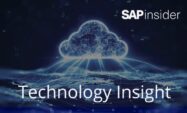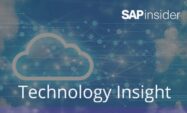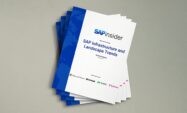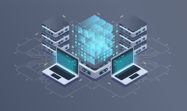SAP Infrastructure
Filter By
Browse By
- SAP Analytics and AI
- SAP Application Development and Integration
- All SAP Application Development and Integration
- SAP ABAP
- SAP ABAP Development Tools
- SAP ABAP Test Cockpit
- SAP API Management
- SAP BAPI
- SAP Basis
- SAP BRF
- SAP Business Application Studio
- SAP CMS
- SAP Design Studio
- SAP Development Tools
- SAP DevOps
- SAP EAI
- SAP EDI
- SAP Extension Suite
- SAP Fiori
- SAP Fiori Elements
- SAP Integration Suite
- SAP Low Code Application Development
- SAP Low Code Automation
- SAP Netweaver
- SAP Release Management
- SAP UI5
- SAP Web Application Server
- SAP Web IDE
- SAP Business Process Management
- SAP Center of Excellence
- SAP CIO
- SAP Customer Experience
- SAP Data and Data Management
- All SAP Data and Data Management
- SAP BW
- SAP BW/4HANA
- SAP Crystal Reporting
- SAP Data Archiving
- SAP Data Center
- SAP Data Governance
- SAP Data Integration
- SAP Data Migration
- SAP Data Quality
- SAP Data Services
- SAP Data Strategy
- SAP Data Visualization
- SAP Data Warehouse Cloud
- SAP DMS
- SAP Document Control
- SAP EIM
- SAP ETL
- SAP ETL Tools
- SAP HANA
- SAP HANA Administration
- SAP HANA Deployment Infrastructure
- SAP HANA Studio
- SAP Master Data
- SAP Master Data Governance
- SAP MDM
- SAP Enterprise Architect
- SAP Enterprise Asset Management
- SAP ERP
- SAP Finance
- All SAP Finance
- SAP Accounting
- SAP AR AP
- SAP Asset Accounting
- SAP Billing Systems
- SAP BPC
- SAP BRIM
- SAP Cash Management
- SAP Central Finance
- SAP Controlling
- SAP COPA
- SAP Cost Center Accounting
- SAP e-invoicing
- SAP FICO
- SAP Finance Automation
- SAP Financial Closing Cockpit
- SAP Financial Consolidation
- SAP Financial Planning
- SAP FX Risk
- SAP General Ledger
- SAP Global Tax Management
- SAP Hyperion
- SAP Order to Cash
- SAP Payment Processing
- SAP Profitability Analysis
- SAP Rebate Management
- SAP S/4HANA Finance
- SAP Universal Journal
- SAP Governance Risk and Compliance
- SAP Human Capital Management
- SAP Intelligent Technologies
- SAP Platform and Technology
- All SAP Platform and Technology
- SAP Business Technology Platform
- SAP Cloud Connector
- SAP Cloud Integration Platform
- SAP Cloud Migration
- SAP Cloud Platform
- SAP Cloud Providers
- SAP Cloud Strategy
- SAP Container Platform
- SAP Digital Asset Management
- SAP Digital Integration Hub
- SAP Digital Signature
- SAP HANA Enterprise Cloud
- SAP HEC
- SAP Hyperscalers
- SAP Infrastructure
- SAP Messaging
- SAP Smart Forms
- SAP Quality and Testing
- SAP Security
- SAP Spend Management
- SAP Supply Chain Management
- All SAP Supply Chain Management
- SAP APO
- SAP Asset Management
- SAP Business Network
- SAP Digital Manufacturing Cloud
- SAP Digital Twin
- SAP EWM
- SAP IBP
- SAP Inventory Management
- SAP Label Printing
- SAP Logistics
- SAP Manufacturing
- SAP Manufacturing Automation
- SAP MES
- SAP MII
- SAP MM
- SAP MRO
- SAP MRP
- SAP Order Management
- SAP Plant Maintenance
- SAP PLM
- SAP Production Planning
- SAP S&OP
- SAP SD
- SAP SPM
- SAP Supply Chain Planning
- SAP Track and Trace
- SAP Transportation Management
- SAP System Administration
What is SAP Infrastructure?
Rapidly evolving from historical on-premise servers to private, public, and hybrid cloud and cloud-like environments, SAP infrastructure includes the systems, hardware, and platforms on which SAP systems and applications are run. Originally, SAP Infrastructure was limited to mainframe computers, though that changed with the client/server architecture included in the SAP R/3 release. While client environments have typically been Microsoft Windows-based systems, host environments normally included Unix systems. Over time, this shifted to include servers running Linux operating systems, though these were still located in data centers local to an organization’s physical locations.
What is SAP Infrastructure?
Rapidly evolving from historical on-premise servers to private, public, and hybrid cloud and cloud-like environments, SAP infrastructure includes the systems, hardware, and platforms on which SAP systems and applications are run. Originally, SAP Infrastructure was limited to mainframe computers, though that changed with the client/server architecture included in the SAP R/3 release. While client environments have typically been Microsoft Windows-based systems, host environments normally included Unix systems. Over time, this shifted to include servers running Linux operating systems, though these were still located in data centers local to an organization’s physical locations.
SAP Infrastructure now includes on-premise or local data centers, private cloud environments or hosting partners, public cloud and managed service providers, and hybrid combinations of these environments. SAP’s transition to a cloud-based company has resulted in a rapidly growing number of solutions and offerings being entirely cloud based, which in turn means that more SAP workloads are moving to the cloud. While these are not always public cloud or hyperscale environments, the infrastructure supporting SAP systems is more cloud based each year.
Organizations offering SAP Infrastructure solutions include: Atos, AWS, Dell Technologies, Google Cloud, HPE, IBM, Lenovo, Microsoft, Navisite, NTT Data, Nutanix, Rackspace Technology, Virtustream, and VMware.
Key Considerations for SAPinsiders:
- SAP Infrastructure continues to move towards the cloud, but SAP S/4HANA remains top of mind when it comes to infrastructure planning. As organizations make plans for the future, they need to determine what their future infrastructure should be. For many this revolves around SAP S/4HANA, while others are simply looking to eliminate older legacy infrastructure by doing a lift and shift to the cloud. This panel discusses what the priorities for organizations have been for SAP Infrastructure, where SAP S/4HANA plays into the picture, what technologies are areas of investment, and what impact RISE with SAP is having.
- SAP workloads, and the infrastructure that they are running on, are moving to the cloud. Based on research conducted by SAPinsider, 88% of organizations are running at least some SAP workloads in the cloud. While this isn’t every system, most of those who are still running workloads in on-premise infrastructure say that they plan on moving those systems to the cloud within the next two years. This article covers which workloads are still running on local infrastructure, which are most likely to be running in the cloud, and what approach organizations are taking when it comes to moving those workloads.
31 results
-

Leveraging Edge Computing to Simplify and Scale
Published: 14/September/2022
Reading time: 8 mins
Over the past decade, there has been a significant shift for many organizations in the infrastructure supporting their business activities. From an environment that was on-premise, many organizations are moving most of their operations to the cloud. There are several reasons for this move, including cost, ease of management, scalability, and flexibility of infrastructure, and…
-

How Do You Better Manage Systems and Improve Resilience?
Published: 14/September/2022
Reading time: 6 mins
How Do You Better Manage Systems and Improve Resilience? How do you better manage systems and improve resilience? Organizations today need to keep their business solutions up and running, and they have focused infrastructure providers on activities that help organizations speed up implementations and reduced both planned and unplanned downtime and increase resilience. However, enterprise…
-

SAP Infrastructure and Landscape Trends 2022
Published: 31/August/2022
Reading time: 1 mins
This report tracks infrastructure and landscape changes in today’s SAP infrastructure and the factors behind them.
-
-

- SAP Infrastructure
 Premium
Premium
Output Management Plays A Vital Role for SAP Customers
Published: 02/December/2021
Reading time: 7 mins
When organizations with hundreds of SAP systems and thousands of printers in different parts of the world make big changes in their SAP architectures, ineffective output management add to the complexity and hamper the success of digital transformation initiatives. This is why it’s important to understand the vital role output management plays for SAP customers.…
-

- SAP Infrastructure
 Premium
Premium
Efficiently manage your SAP systems in hybrid environments with SAP Landscape Management
SAP Landscape Management is an orchestration and automation solution that assists with managing your SAP systems deployed on-premise, private cloud, Infrastructure-as-a-Service (IaaS) aka Hyperscaler environments, or in a hybrid setup. SAP Landscape Management helps many customers in the world to be more efficient, flexible, and resilient. The solution supports in the journey to be an…
-

- SAP Infrastructure
 Premium
Premium
The complete & open hybrid Infrastructure for SAP
One of the biggest goals of organizations that are moving to SAP S/4HANA is to increase reliability and flexibility while reducing downtime during the transition. Red Hat and SAP have shared a long and successful history, and Red Hat is committed to helping SAP customers on their journey to achieve these goals and become an intelligent…
-

- SAP Infrastructure
 Premium
Premium
How to Automate and Accelerate System Copy and Refresh with SAP Landscape Management
System copy/refresh is an essential process that has to be done on a regular basis to keep the test systems in sync with the latest productive business data. It is very time-intensive, resource-consuming and error-prone, especially as system landscapes become more complex. Learn how SAP Landscape Management (LaMa) helps to simplify, automate and orchestrate the…
-
-

Modernize your SAP landscape with Red Hat and Intel
Published: 28/June/2020
Reading time: 1 min
Organizations are digitally transforming to take advantage of growth opportunities in new markets, adapt to evolving customer behaviors and preferences, and combat increased competitive pressure. As a result, modernizing infrastructure with increased agility, flexibility, manageability, and security is a top long-term goal for 49% of organizations. Technologies like containers, microservices, and cloud infrastructure support these…
-

Host Your SAP Systems in a Fast-Performing, Highly Available, Nondisruptive, Managed Environment
Published: 28/May/2020
Reading time: 13 mins
For companies running SAP software, SAP’s announcement that it is extending the end-of-mainstream-maintenance deadline from 2025 to 2027 means that organizations now have another two years to decide when and how to build a migration plan to SAP S/4HANA into their roadmap. This transition will be a complicated one for many companies and is a…
-

Optimize Remote Output and Print Management for SAP Systems
Published: 01/February/2019
Reading time: 9 mins
Matthew Shea: Hello, and thanks for coming to today’s live Q&A on optimizing remote output and print management for SAP systems, particularly the UniSpool solution. I am joined by Goosen de Bruin, Managing Director at Solipsis, Johan Harmsen, Software Architect at Holland House b.v., and Tessa Hofman, Solipsis Group. We are looking forward to a…
Featured Experts
-

Akash Kumar
Associate General Manager, HCL
-

Graham Robinson
SAP NetWeaver, ABAP Development, UI Design, SAP Infrastructure
SAP Mentor and Independent IT Professional at Yelcho
Become a Member
Unlimited access to thousands of resources for SAP-specific expertise that can only be found here.
Upcoming Events
-

SAP TechEd on Tour, powered by Mastering SAP
November 12 - 14, 2025
Sydney, New South Wales
Australia
View Event
Your request has been successfully sent